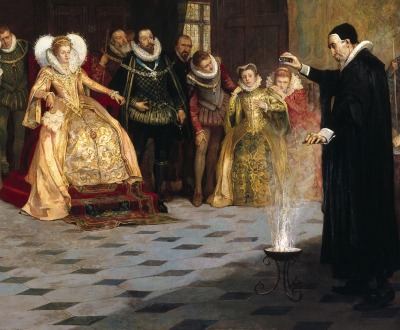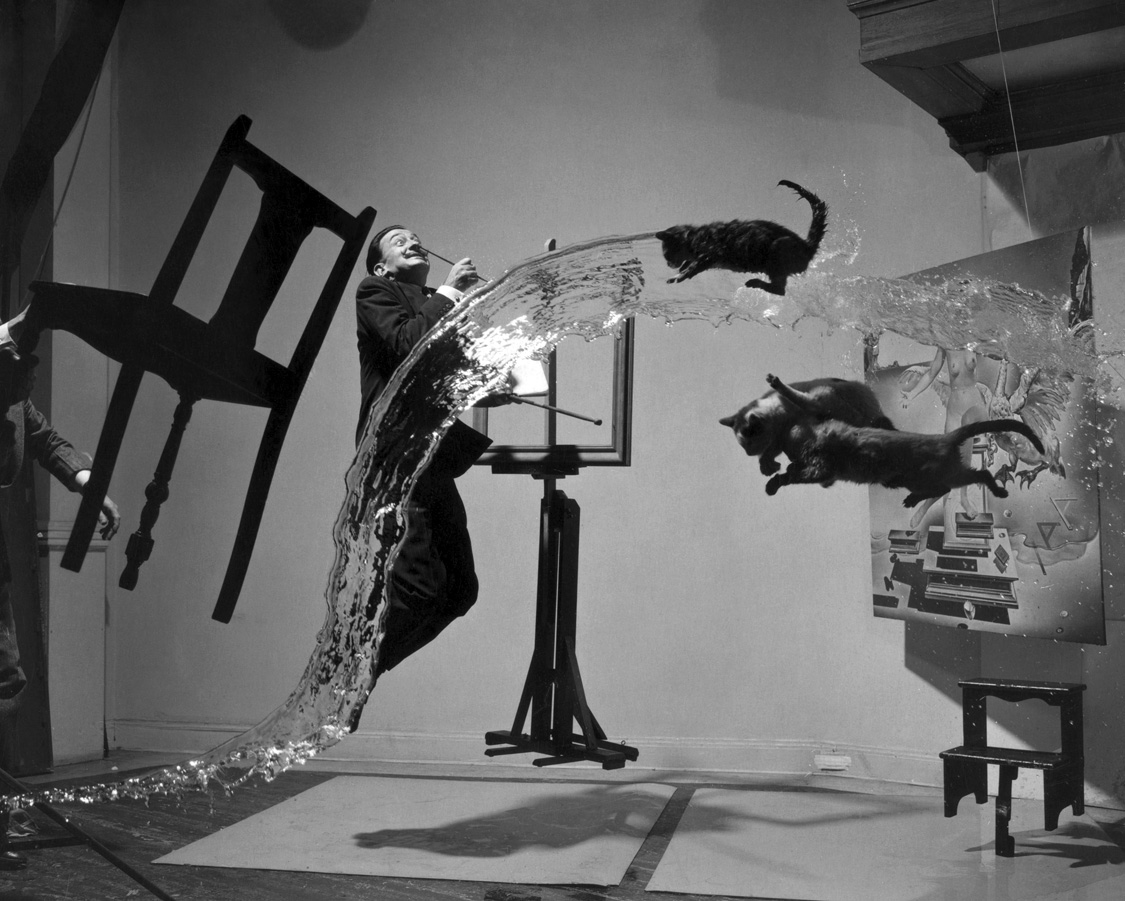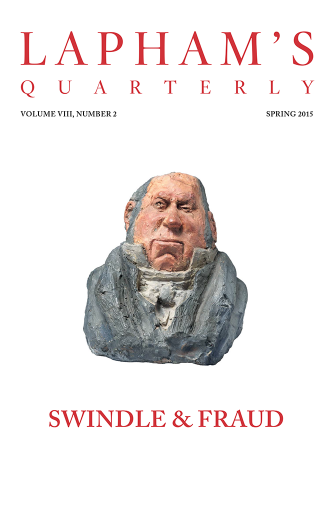Many are the wonders of the world, and none so wonderful as man.
—Sophocles, 441 BCA Well Without a Bottom
Have devils, demons, and spirits disappeared from the world, or do we just no longer know their names?
By John Crowley

John Dee Performing an Experiment before Queen Elizabeth I, by Henry Gillard Glindoni. Wellcome Library (CC BY 4.0).
Devil or angel, I can’t make up my mind
Which one you are I’d like to wake up and find
—Blanche Carter, “Devil or Angel,” 1955
1. The Wool-Sweater Problem
In the spring of 1968, Cyrena Pondrom, an English professor at the University of Wisconsin, held a series of conversations with the novelist and story writer Isaac Bashevis Singer. The questions were wide-ranging, and so were the answers. At one point Professor Pondrom expresses puzzlement at a line in Singer’s novel The Slave: “He had been driven, he knew, by powers stronger than himself.” What, she asks, are these powers? “I really mean powers,” Singer says. “It’s not for me just a phrase or a literary way of saying things. I believe that powers which we don’t know take a great part in our life.” But surely there is a difference, she suggests, between natural powers and demonic powers. Singer isn’t so sure. “They may be divine powers or other kinds of powers…The supernatural for me is not really supernatural; it’s powers which we don’t know.”
“For example,” he says, “a man who took off his wool jacket five hundred years ago at night and saw sparks might have thought that these sparks are supernatural, because there was no reason for him to think that a wool sweater should produce sparks. But we now know what they are…The things we know we call nature and what we don’t know we call supernatural.”
Singer considers the possible explanations that people of former times could have had for startling physical events as unknown but natural (static electricity) or unknowable and supernatural. But this doesn’t exhaust the possibilities. Indeed most of the people of the past whom Singer imagines pondering the phenomenon of sparks would have placed it in an intermediate category between natural and supernatural. Those sparks—like the sparks that rise when a cat’s fur is brushed back, spectacular in the dark—were caused by imps, small devils of everyday life, invisible but apparent, who were connected by occult chains of causality both to fire and to cats, and who also fooled around in the human realm, stealing things and playing tricks. They were related, in one direction, to potent demons and the Devil; along another direction, to fairies, brownies, and an array of similar beings. These thought worlds of our forebears, and the beings who inhabited those worlds, underlie our own, even as those ancestors themselves lie under our feet. For better or for worse they have long accompanied people in their daily and nightly doings, undergoing shifts of characterization that depended on how the universe and its inhabitants were understood, shrinking or growing in size, losing or gaining status and fearsomeness, down to the present. If certain of the beings who once shared our world seem to have disappeared or died, it may only be because they have been renamed—not once but many times.
2. Melancholy Dizzards
Back in what has come to be called the early-modern period in Europe (roughly what used to be the Renaissance and the Reformation up through the Enlightenment) it wasn’t just peasants and the unlearned who lived in a world of largely unseen but busy spirit creatures. In fact if you were a student of old books, you learned from Greek Neoplatonists and Latin poets about a vast array of beings, igneous spirits of the remote heavens, souls of the great dead, minor gods of field and forest, naiads in the water, dryads in the trees, black chthonian dogs from beneath the earth. Many were evil, or at least dangerous. “Aerial spirits or devils are such as keep quarter most part in the air, cause many tempests, thunder, and lightnings, tear oaks, fire steeples, houses, strike men and beasts, make it rain stones…wool, frogs, etc.…They cause whirlwinds on a sudden, and tempestuous storms; which though our meteorologists generally refer to natural causes, yet I am of [the] mind…they are more often caused by those aerial devils, in their several quarters.”
That’s Robert Burton (1577–1640), inquiring polymath and cleric, maybe a little more credulous concerning his sources than some, but on the whole representative of an open-minded understanding of the world he encountered. Burton suffered lifelong from an array of mental and physical troubles that doctors of the time could class as melancholy, and he set out in his huge book The Anatomy of Melancholy to collect everything about this intractable condition, its possible cures and alleviations, and its causes, ranging from climate and diet and the composition of the body as determined by the sufferer’s natal stars, to more occult possibilities. At certain points his investigation leads him into a self-admitted Digression (lesser digressions are frequent). One is a Digression of Air, which includes a remarkable rundown of the competing cosmological schemes of the day, from Copernicus and Ptolemy to Tycho Brahe, Galileo, Giordano Bruno, and Kepler (“But hoo! I am now gone quite out of sight, I am almost giddy with roving about”). Another is a Digression of Spirits.
What are spirits, first of all? Burton refers interchangeably to “spirits” and “devils,” and for the most part excludes good angels from his discussion. He dismisses the ancient idea that spirits/devils are the incorporeal souls of the dead; he believes (with many of his authorities) that they have bodies, but bodies made of spirit, which is a superfine stuff intermediate between physical and immaterial, and having qualities and limits as material things do. This was a distinction common in the medical and psychological theorizing of the day. “Pneumatic,” or spirit, bodies were “slender,” were as quick as Shakespeare’s Puck, who can circle the earth in forty minutes, and were changeable in shape and size. “Many will not believe they can be seen, and if any man shall say, swear, and stiffly maintain, though he be discreet and wise, judicious and learned, that he hath seen them, they account him a timorous fool, a melancholy dizzard, a weak fellow, a dreamer, a sick or a mad man,” but there are plenty of renowned and even saintly people who have seen and had various relations with them. “The air,” Burton concludes, “is not so full of flies in summer, as it is at all times of invisible devils.”
What were they doing? They all had their “offices,” ruling themselves according to strict hierarchies, topped by Satan. Some devils had lowly jobs tending to us humans as a cowherd tends cows, some were great lords—as among us. Were they all “sublunary,” living beneath the moon’s sphere, or did they go all the way up? Opinions differed. Could they die? Some said they were long-lived but mortal, others disagreed. What they did in the lore that fills Burton’s pages was pester, tease, trick, tempt, and (if they could) bring us to damnation. If they caused disease, particularly a black melancholy like Burton’s, it was for that purpose. If you believed the tales, it was dreadfully easy to become infected by bad spirits; Burton relates the story of a nun who forgot to cross herself before eating a lettuce, and a devil snuck into her along with it. “The Devil,” Burton writes, quoting a Dutch physician named Jason Pratensis, “being a slender incomprehensible spirit, can easily insinuate and wind himself into human bodies, and cunningly couched in our bowels vitiate our healths, terrify our souls with fearful dreams, and shake our minds with furies,” as well he knew.
At the same time Burton tells of cunning workers who could seem for a time to get the better of a devil—like the magician Heinrich Cornelius Agrippa von Nettesheim, whose dog had one tied to its collar, or the Swiss-German alchemist Paracelsus who had one locked up in the pommel of his sword. Devils could tell their human masters deep secrets, since it was generally agreed that the Devil was the smartest creature in the universe except for God himself; the information he provided about the otherwise unknowable occult qualities of the world was real, though sinful to acquire in that way. But in the end the Devil was always the winner in these partnerships. Christopher Marlowe’s Doctor Faustus (who wanted to be “as cunning as Agrippa was”) cries helplessly at the last moment of his earthly life, “I’ll burn my books”—but of course it’s too late then.
3. Weird Science
The accepted opinion now about the demonic world is that it vanished away bit by bit with the growth of science, which punctured ancient fantasies and dismissed infectious fears. But demonology—the study of the spirit world and its interaction with human life—in fact long shared intellectual space amicably with advancing mechanics and physics. From the acme of Scholasticism in the thirteenth century right through the oncoming of the New Science in the seventeenth, doctors, lawyers, priests, and philosophers made a huge effort to investigate the realm of the hidden yet pervasive, the spiritual but not supernatural, the abnormal and unlikely yet basically mundane. (The learned word for this middle realm was “preternatural.”)
They were not all as wide-eyed as Burton. They could and did challenge certain popular beliefs about spirit powers, but given their assumptions they could not exclude, a priori, devils and the Devil, werewolves and witches’ Sabbaths, pagan gods and Christian angels. One practical goal of the investigations was determining who had subjected themselves to demons, and what evil they could actually do through the demons’ power. The Devil’s reach, by definition, excluded the miraculous—the unaccountable power of God to do whatever God was pleased to do. And though the Devil might be able to carry witches through the air to sabbaths, he couldn’t actually transform them into crows or pigs—or transfer their souls into wolves, or bring them back from the dead. Our bodies and minds were the Devil’s playground, but our souls were our own, to lose or to save.

Luna Park, Coney Island, New York, 1906. Photograph by Eugene Wemlinger. Brooklyn Museum, Brooklyn Public Library, Brooklyn Collection.
What can be known in any given period is a function of what can be described, and not the other way around. In his 1997 book Thinking with Demons, Stuart Clark shows that demonological thinking depended to a great degree on Greek ideas that described the constitution of matter, the cosmos, and the human person as a system of contrary entities. Love (concord) and Strife (discord) were the primary contraries, and everything on earth or in the heavens could be shown to tend toward one or another contrary pole or opposite subsumed under those two: hot or cold, wet or dry, active or passive, attractive or repulsive. This leads Clark to show how demonology was a philosophical or legal or scientific investigation, but also, and above all, a discourse—a rhetoric. Placing the Devil (Strife) and Christ (Love) in opposition, demonologists as different as Jean Bodin and King James I could categorize all lesser phenomena in linguistic antitheses that counted as analysis, thus knowledge. God is Truth; the Devil, therefore, is Lies. If there were nine choirs of angels reaching to the heavens, there had to be nine hordes of demons reaching to the center of hell; Satanic rituals in the Sabbath were performed exactly as the rituals of religion, but backward or upside down—instead of decent respect, naked lewdness; instead of sermons, nonsense or obscenities; instead of a pure white Host, a slice of blackened turnip; the kiss of peace delivered not to the priest’s cheek but the Devil’s backside.
Clark shows that as this rhetoric grew ever more pervasive it also set the conditions for its own dissolution, in that there was no end to the contrarieties that could be established, no end to the game, which came to be seen as merely a game. He doesn’t analyze an imbalance in the symmetry that also excited doubt. If God’s angels matched the Devil’s minions in extent and power, if they were just as ubiquitous, just as smart and maybe smarter than their counterparts, then why were angels so relatively absent from human life, and unable or unwilling to do as much good for humans as the devils were to do harm? If the Devil gave false (though usable) goods, shouldn’t angels proffer modest but real goods? It was generally agreed that we are each accompanied by our own angel guardian as well as our demon tempter, right shoulder and left shoulder, but the angel seemed always short on tangible rewards. You could sell your soul to Lucifer; why couldn’t you make a profitable covenant with Michael?
In 1508 that question was put by the Holy Roman Emperor Maximilian to Bishop Trithemius, his spiritual adviser: Why can a wicked man get power over evil spirits, when a good man can get nothing out of an angel? Trithemius, as it happened, was the right man to ask.
Though an abbot and a bishop, Trithemius seems to have been far more interested in magic of all kinds than in orthodox theology. He accumulated a large library in the little abbey of Sponheim, where his handful of monks were kept busy copying out titles like The Four Rings of Salomon, On the Offices of Spirits (attributed to King Solomon), The Book of Simon the Magician, and on and on. His collection fit (just barely) within the bounds of what the Church regarded as licit investigations into the occult natural causes of things, and he covered himself by fiercely denouncing sorcery and demanding the death penalty for witches.
His most whispered-about work was the Steganographia. It appears at first to be an innocent study of cryptography, in which nonsense paragraphs that look like magical-sounding incantations actually encode simple messages. That was misdirection. The later parts of the book are full of real incantations, methods of reaching angelic intelligences and getting them to do your bidding—specifically, carrying messages instantaneously to far-off associates and fellow mages through the agency of the stars and planets who rule time. Cornelius Agrippa (the one with the devil on his dog’s collar) said he often used Trithemius’ method to send his thoughts to others, and it worked like, well, like a charm, reaching intended recipients within twenty-four hours “without the intercession of any spirit.”
That was prevarication. Of course the method depended on reaching spirits—spirits intelligent enough to understand the intentions of the mage and powerful enough to carry them out. The Steganographia invoked the presiding angels of the planets, the rulers of time, through images, words, and symbols, which could have no power over mindless matter. All the authorities were agreed on that. Trithemius and Agrippa were asking spirits for favors. The only question was: were those planetary spirits really good or bad? Angels or devils?
The subject was fraught with difficulty. The pagan gods had long before been reconceived by Christianity as potent devils, and several of those former gods were still identified with their eponymous planets, which were widely assumed to have a determining effect on earthly life of every kind. Their differing characters had been known for centuries, and drawing down good planetary influences (Jupiter, Venus) to counter baleful ones (Mars, Saturn) was big business; so long as you used natural methods—fumigations, planet-specific jewels, foods, and medicines—you could stay on the right side of the spirit police. But if you went further—sang hymns, offered sacrifices and prayers to get in touch with what might be angels and might not—you had better prevaricate.
On the other hand, since the stars were seen as creations of incorruptible beauty and worth, central to God’s universe, surely they must be infused with or at least moved around not by devils but by good spirits of some exalted sort—and wouldn’t those be angels, seraphim? Trithemius followed a scheme matching up not the old gods but specific angels with planets: Anael with Venus, Samael (the Hebrew Angel of Death) with Mars, Gabriel with the Moon, Michael, the Sun. If good beings like that could be reached, who knew what they could do for the right supplicant?
4. Hello, Central, Give Me Heaven
In 1563, the English philosopher and mathematician John Dee, owner of England’s largest private library, was on a book-buying trip in Germany and heard about a great prize: a rare manuscript of the Steganographia had turned up in Antwerp, and Dee made a special trip to copy it out: “The most precious jewel that I have yet of other men’s travails recovered.”
Dr. Dee, physician, astrologer, scientific popularizer, and mystic (there really isn’t a word for what his role was in his time), was intensely interested in methods for contacting angelic powers to gain knowledge and reach for himself and mankind. He was eager to try out the “calls” that Trithemius had evolved, though in the end the Bishop’s complex encodings defeated his attempts to reach angelic ears. Dee also used a variety of “showstones”—crystal balls—and obsidian mirrors, on the principle that angels, being creatures of light, might be attracted to repositories or collectors of light. And after years of futile efforts, he was finally more successful in his quest than anyone else had ever been; some very unlikely angels came to talk with him, at greater length than with anyone until a few served up some thirty volumes of theology to Emanuel Swedenborg, or the angel Moroni directed Joseph Smith to a set of golden plates containing the Book of Mormon. Dee’s angels promised a universal reformation of the world that he would be spearheading.
Nothing is so easy to fake as the inner vision.
—Robertson Davies, 1985Actually, Dee never spoke directly to or heard the voice of an angel. The angels spoke through a medium, Edward Kelley, a man much younger than Dee and an even stranger soul. Kelley arrived at Dee’s house in March of 1582, and that first night saw figures in the showstone that Dee put before him. They became partners in angelic pursuits for the next six years.
Dee never doubted that Edward Kelley was receiving messages from angels—standard ones like Michael and Uriel at first, then others like Il, a jokester and kidder, and Galvah, an old woman dressed all in red, and little Madimi, a sprite who grew into a fearsome, challenging temptress. They seemed to have no ranks or hierarchy, though some promised more than others. They resemble the spirit guides of the modern medium, and are no doubt the same thing, whatever thing that exactly is; few mediums, though, are capable of producing, apparently entirely ad lib, the truly moving or startling passages of prophecy and adjuration Kelley could. Before he ceased his scrying, or divination through crystal balls, he had transmitted hundreds of pages of angelic hectoring, teasing, teaching, warning, and playacting, as well as an unimaginably tedious method of taking down and employing a universal language said to be that of men before the Flood.
The conversations lasted until the angel Madimi commanded that her supplicants have their spouses in common. Dee was astonished that God’s angel could command such a thing, but he did it, or at least attempted it. The record is clear, and a unique record it is: four Elizabethans, Dee, Kelley, Dee’s somewhat fiery wife Jane, and Kelley’s wife Joanna, obeying naked Madimi (who “sheweth her shame also,” Dee notes) and bedding down together. What happened after that went unrecorded, or the recording is lost. Dee and Kelley soon parted ways, and Dee never reached spirits of any kind again.
Had he been deceived by the Father of Lies? Were his spirits to be consigned to the Evil side of the ledger, not to the Good? Because early-modern demonologists drew for their knowledge of spirits not only on contemporary witchcraft and sorcery trials but also on pre-Christian lore and learning, in which spirits—daemones, in Greek or Latin—could be active or indolent, good or bad, smart or stupid, high or low, friends or enemies to mankind or simply indifferent to it, such questions couldn’t finally be resolved. The strictest Protestant or Calvinist divines tried to cancel the issue by simply positing that all spirit power in the universe belonged to God alone, no matter what wonders devils, witches, sorcerers—or saints and angels—seemed to be effecting. (Which didn’t mean that trafficking with the Devil was inoffensive.) Others lived with the contradictions. Burton’s slovenly way of entertaining every wild story or notion he got hold of and then admitting that some other writer had “exploded” this or that one was probably more representative of educated people’s thinking. William Shakespeare often sounds like he thought in that way.
John Dee’s reliance on the figures that came out of his glass, whom he continued to trust despite their weird and patently sinful behavior and their constant reluctance to actually deliver on the promises they made, suggests that he knew in some part of his consciousness that whatever they were and wherever they had come to him from, they were neither angels nor devils in any restrictive sense. He loved them and took them for what they proved themselves to be; their gifts in his mind were real and their purposes at bottom good, or good enough.
5. Trance Lecturers
On an October afternoon in 1917, William Butler Yeats’ new bride Georgie surprised him by trying to use a common tool of contemporary spiritualists—automatic writing. She’d shown no interest in or talent for it before, but what she almost immediately began to produce seemed to Yeats (who was devoted to occult investigations) profound and thrilling, and he insisted she continue. He would put questions and she would write answers, which turned to long and scattered expositions of a kind of universal spiritual geometry. When Yeats offered to spend the rest of his life ordering and expounding the new knowledge, the spirits’ answer was no: “We have come to give you metaphors for poetry.”
It’s remarkable (though maybe it’s actually to be expected) how much Yeats’ transactions with spirits resemble John Dee and Edward Kelley’s. Yeats knew of Dee and Kelley, though how familiar he was with the angelic conversations I don’t know. But like Dee’s, these spirits—Yeats can only name them Communicators, and doesn’t speculate on their residence or provenance—were often reluctant to make complete sense (which can be interpreted as knowing more than can be easily said to mortals). Yeats reports one such confusing session after which he was told, “Remember we will deceive you if we can.”

“Dalí Atomicus,” 1948. Photograph by Phillipe Halsman. © The Granger Collection, NY.
Though he was careful to distinguish his experiences from the “popular spiritualism” of the time, Yeats’ spirit informants and the means he had of accessing them (trance and automatic writing) were certainly part of the widespread recrudescence in his time of spirit presences. These modern spirits were fitted into a different mental universe than Trithemius and Burton lived in. They were usually understood as the souls of the dead, and rather than sharing the earth with the living they inhabited a realm of their own, neither heaven nor hell, from which now and then a medium might get a message. The question raised about them was not Are they good or are they evil? but Are they real? The bad operators in the new dispensation were not sorcerers and witches dealing with evil spirits but fakers and hoaxers dealing with nothing.
The history of modern spiritualism actually begins with a spectacular and decades-long fraud. The Fox sisters of western New York, the same “burned-over district” where Joseph Smith had his experiences with angels, began communicating with spirits of the dead in 1848 through their “rappings,” which everyone heard and could be easily understood as coded spirit responses to questions. The sisters went on to a triumphant international career, their mediumship passing all tests set for them, until Margaret Fox confessed in 1888 that they had made the rappings themselves by cracking their big toes—not something investigators had thought to check. Fox later retracted her confession; many adherents continued to believe that the sisters had been true mediums.
Spiritualism developed a suite of up-to-date methods. Mediums had to deal with the same charges faced by Burton, that those who claimed to see the spirits were mad melancholy dizzards, but photographic plates could seem to make “objective” records of things unseen—fairy presences, ectoplasm (a substance rather like the “spirit” of the old magicians) and double-exposure ghosts. The Ouija board, introduced as a parlor-game toy in the 1890s, was quickly adopted by spiritualists and employed as a means of communication for decades; in the 1970s the poet James Merrill and his partner used one to get in touch with a large number of spirits—including W.H. Auden’s—who certainly came to bring them metaphors for poetry.
In the society of men, the truth resides now less in what things are than in what they are not. Our social realities are so ugly if seen in the light of exiled truth, and beauty is almost no longer possible if it is not a lie.
—R.D. Laing, 1967As a movement, or religion, or enthusiasm, spiritualism has fallen some from the days when “trance lecturers” like the Fox sisters could make good livings and William James and Arthur Conan Doyle were prominent followers. The Society for Psychical Research, founded in 1882, still investigates evidence and reports of ghosts, psychic phenomena, and spirit communications—now called “paranormal,” a word replacing while neatly matching the “preternatural” of Burton’s day—and sometimes getting entangled like old-time demonologists in the effort to account for observations in something like current scientific terms.
Spiritualism has always been an optimistic faith, and the Devil plays no part in it, though the beings contacted are often “playful,” tricky like Madimi and company, and can seem to suffer from ADHD. But Alison, the medium in Hilary Mantel’s acerbic 2005 novel Beyond Black, sees it differently. Alison, a fake fortune-teller, has actual spirit guides, evil ones too, and knows the dead well: “It’s no good trying to enlist them for any good cause you have in mind, world peace or whatever. Because they’ll only bugger you about. They’re not reliable…They don’t become decent people just because they’re dead.”
6. A Well Without a Bottom
Isaac Bashevis Singer told Cyrena Pondrom in 1968 that he’d read the spiritualist seer Madame Blavatsky and was himself a deep scholar of psychic research. His tales drew on the legend and folklore of his childhood and youth (as Yeats’ early poems did) because, he said, folklore has already “given clothes” to ideas. “By really calling demons names and assigning to them certain functions, it makes it more concrete,” he said, a concreteness without which writing “becomes philosophy, or brooding.” But behind the old names and functions, Singer says, are real powers. “There are millions and millions of powers, even now, of which we have no idea, which take part in our life, push us or pull us or do all kinds of things with us. It is true I don’t know what these powers are. They may be divine powers or other kinds of powers…Nature is a well without a bottom.”
The young William Yeats, traveling in the Celtic twilight around his home in Sligo and collecting stories of Ireland’s powers, its endless pookas, fairies, witches, and leprechauns, asked his neighbor Paddy Flynn if he had ever seen the fairies. Paddy replied, “Amn’t I annoyed with them?”
It has been shown that in America today a solid majority believes in devils and angels working among us, not to mention significant percentages who believe in haunted houses and ghost whisperers, and though we can assume that far fewer call such powers fairies or imps or naiads, we have not yet left behind the spirits that have accompanied us for as long as we have been human. And wherever it is we now locate them—inside ourselves, in the black hearts of others, in the grand shared net of consciousness, or—even now—in inaccessible and unvisitable regions of the real, we never will. We look behind us, sensing someone regarding us, and see no one. We swat at something teasing, something momentarily present by our heads—I do. Aren’t we annoyed with them? We simply no longer know their names.




